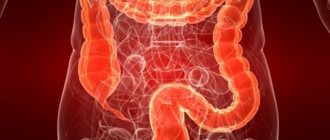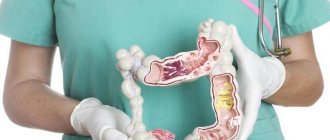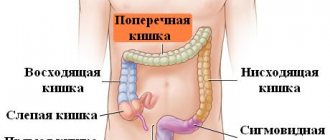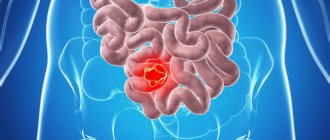The human intestine is home to various types of beneficial bacteria. The main part of the normal microflora (95-98%) is represented by bifidobacteria and lactobacilli. These representatives exist in symbiosis with each other and various types of beneficial bacteria. That is, they are in a “mutually beneficial tandem” to create a favorable environment and conditions for their life.
Symbiotics are a combination of probiotic preparations containing several strains of beneficial microorganisms. Most often, bifidobacteria and lactobacilli are combined. They are actively used for the prevention and treatment of dysbiosis, immunodeficiency conditions and dyspeptic disorders associated with insufficient digestion or inflammation in the colon.
Beneficial features
- Regulate acidity in various parts of the digestive system. During their existence, bifidobacteria secrete biologically active compounds (various types of acids - lactic, acetic, formic and succinic), which help reduce the pH in the intestinal lumen to 5.0. Lactobacilli also produce lactic acid, which creates an “acidification” zone in the lower digestive tract (pH reaches 4.0).
- Antimicrobial action. Symbiotic bacteria displace competitive microorganisms - pathogenic and opportunistic pathogens of gastrointestinal infections - from their habitat. This property is achieved by an acidic reaction in the intestines at a low pH. Such conditions are unfavorable for the life of pathogenic microorganisms. In addition, the main representatives of beneficial microflora secrete antibiotic-like substances (lysozyme, bacteriocins, alcohols, lactocidin, lactolin, acidophilus and others). These compounds inhibit the growth and reproduction of putrefactive and pyogenic bacteria.
- Synthesize vitamins. Bifidobacteria and lactobacilli are involved in the formation of ascorbic, nicotinic, pantothenic and folic acid. Biotin, vitamins K and group B are also actively synthesized.
- Digestive action. Symbiotics participate in the metabolism of protein compounds and bile acids. Break down high molecular weight carbohydrates, lipids and dietary fiber. Due to this, the main representatives of normal microflora improve the processes of digestion and absorption of nutrients. Beneficial bacteria also form end products of protein breakdown, which stimulate the contractile activity of the intestinal wall - peristalsis. They utilize undigested food residues and inactivate biologically active substances secreted with gastrointestinal juices.
- Immunomodulatory property. Bifidobacteria and lactobacilli stimulate the production of immunoglobulins and interferon. Antibiotic-like substances are released that create a nonspecific factor of the body's immune defense.
- Metabolic action. Beneficial bacteria enhance the absorption of calcium ions, iron and vitamin D. They synthesize biologically active substances - estrogens, promazine, colchicine, digoxin and others.
- Detoxifying property. Symbiotics immobilize and remove toxic products with feces, including metals, phenols and other xenobiotics.
The most popular sorption preparations
The probiotic formula can include not only live microorganisms, but also substances with sorption properties. In such preparations, live bacteria, united in small groups, are attached to sorbents. Activated carbon is usually used as the latter. Due to the presence of a sorbent, a larger amount of active probiotic substances enters the intestines. Sorptive probiotics have a milder effect on the intestinal mucosa. All components together provide effective cleansing of the body, restoration of pH acidity, prevention of poisoning and much more.
Linex
Estimated cost – 260 rubles.
Libenin is used as the active substance in the drug. It includes such live lyophilized lactic acid bacteria as Lactobacillus acidophilus, Bifidobacterium infantis, Enterococcus faecium. All these substances, entering the intestines, synthesize vitamins such as thiamine, riboflavin, adermin, cobalamin and others, and also participate in the metabolism of bile acids. Thanks to lactobacilli, the intestinal pH balance becomes more acidic, which leads to a decrease in the activity and growth of pathogenic bacteria. Also, Linex components prevent the attachment of harmful microorganisms to the intestinal mucosa.
The product is presented on the market in the form of capsules. The medication does not contain aggressive components, therefore, if the dosage is observed, it is absolutely safe for the body as a whole. It can be used even in infancy. However, for this purpose it is recommended to remove the capsule and mix the internal contents with milk.
Indications for use:
- intestinal disorders;
- heartburn;
- gas formation;
- constipation;
- diarrhea.
The drug is contraindicated only for people with hypersensitivity to the components of Linex.
Linex
Advantages:
- the medication does not contain aggressive components;
- can be used for infants.
Flaws:
- not detected.
Probifor
Estimated cost – 730 rubles.
The drug is presented on the market in the form of capsules and powder. It can be used at any age, starting from the first day of life. Live bifidobacteria are used here as active substances, united in small groups and attached to a sorbent substance; lactose serves as an auxiliary component.
Thanks to sorbed bifidobacteria, the drug quickly and effectively copes with diarrhea, since these substances can not only destroy pathogenic bacteria, but also create antibacterial substances. The unique probiotic formula allows you to use the product even in case of poisoning and intoxication, without resorting to antibiotics. Experts prescribe this medication in a wide range of cases. This can be preparation for surgery, the postoperative period, childbirth, cesarean section, as well as for influenza and ARVI as an addition to treatment.
Indications for use:
- irritable bowel syndrome;
- colitis and pancreatitis;
- eczema;
- allergy;
- bacterial vaginitis.
It is contraindicated to take the medication if you are intolerant of the active ingredients.
Probifor
Advantages:
- wide spectrum of action;
- addition to treatment.
Flaws:
- not detected.
Bifidumbacterin forte
Estimated cost – 210 rubles.
The medicine is presented on the market in the form of capsules and powder. The active component here is live bifidobacteria grouped on activated carbon, due to which they not only normalize intestinal balance, but also eliminate intoxication. In a short period of time, the probiotic completely restores the columns of beneficial bacteria, removes all toxins, and also removes waste products of pathogenic microbes from the gastrointestinal tract.
The medication is prescribed both in case of disruption of the intestines and stomach, and in the pre- or post-operative period. The components of the drug have an active effect against poisoning, constipation and diarrhea. “Bifidumbacterin forte” can be given even to infants. However, it must be taken into account that children under 3 years of age can only be given the product in powder form. Capsules are prescribed only after reaching this age.
Indications for use:
- constipation;
- loose stools;
- poisoning;
- allergic reaction;
- intestinal infection.
It is contraindicated to take the drug in case of lactase deficiency and individual intolerance to the components of the medication.
Bifidumbacterin forte
Advantages:
- Can be given even to infants.
Flaws:
- not detected.
Types of symbiotics + names of drugs
| Group of drugs | Titles |
| Bifido-containing |
contain 6 strains of bifidobacteria |
| Lactose-containing |
|
| Complex probiotics based on bifidobacteria and lactobacilli |
|
| Bifido- and lactose-containing probiotics with other representatives of normal intestinal microflora |
|
Types of probiotics
Bacteria useful for digestion and the bioactive additives that contain them can be divided into several types (generations).
- 1st generation. The first generation includes single-component preparations containing only one culture (strain) of beneficial bacteria. These drugs include: Bifidumbacterin, Lactobacterin, Colibacterin.
- 2nd generation. The second generation represents self-eliminating antagonists. Such a complex and cumbersome name means that these bacteria are not permanent residents of the human gastrointestinal tract and, when they get there, are quickly eliminated from the body. However, this does not diminish their role in digestion, which is why special preparations are produced that can be used to intentionally “plant” beneficial microflora. The course of treatment is enough for the bacteria to have a positive effect on the intestines. They are prescribed for mild forms of poisoning, compensated dysbacteriosis, and non-infectious diarrhea. This category of bacteria mainly includes yeast-like fungi and spore-forming bacteria. Among the representatives of the second generation are: Biosporin, Baktisubtil, Sporobacterin.
- 3rd generation. The third generation of probiotics (symbiotics) is most widely used due to its versatility. The drugs contain several strains of bacteria or additives that enhance their effect, which can significantly influence the digestion process and protect the gastric mucosa from the effects of aggressive drugs. For example, this applies to antibiotics - when prescribing this category of drugs, it is extremely important to maintain the balance of microflora, otherwise, instead of curing the infection, the patient will develop digestive problems. The category of multicomponent drugs includes Bifiliz, Linex, Acipol, Bifiform, Acylact.
- 4th generation. The fourth generation includes sorbed probiotics. This makes it possible to introduce not just single bacteria into the digestive tract, but entire colonies of microorganisms. Once in the gastrointestinal tract, they are able to attach to the walls of the mucosa, thereby providing a dense membrane. Such probiotics are called live; they provide the greatest effect, remaining active for a long time. Probiotics of this generation are Probifor, Bifidumbacterin forte, Florin forte.
Sources of symbiotics
Products
Dairy and fermented milk products:
- acidophilus milk, buttermilk;
- bio-yogurts with active and live cultures (bifidobacteria, lactobacilli, thermophilic streptococci and kefir fungi) and a short shelf life (several days);
- kefir, yogurt, fermented baked milk;
- fermented soft cheeses (“Gouda”);
- cottage cheese, sour cream.
Products and dishes based on soybeans:
- Japanese soup (paste) “Miso”;
- Indonesian flatbread "Tempe";
- Tofu cheese;
- soy sauce.
Homemade preparations prepared using water, sea salt and sugar, without adding vinegar:
- sauerkraut;
- pickled cucumbers, tomatoes;
- soaked apples.
Vegetables:
- artichoke;
- leeks and onions;
- tomatoes;
- green pepper;
- cabbage;
- pumpkin.
Fruits:
- bananas;
- kiwi;
- oranges;
- apples, pears;
- pineapples;
- mango;
- avocado.
Berries:
- red grapes;
- cherry;
- watermelon.
Bread made with kefir sourdough, without the use of yeast.
Cereals:
- beans;
- corn;
- millet;
- Hercules.
Good quality dark chocolate (high percentage of cocoa beans).
Preparations (dietary supplements) based on lacto- and bifidobacteria
“Bacteriobalance” is a domestic symbiotic produced by. Bifidobacteria and lactobacilli in the preparation are preserved in their natural form. These beneficial microorganisms get along well with each other. When they enter the intestines, they actively multiply.
The drug is available in capsules (60 pieces), packed in plastic bottles. Used for infectious and inflammatory bowel diseases, weakened immunity and various manifestations of dysbacteriosis. “Bacterial balance” improves metabolic processes in the body and activates digestive function. Also, the drug can be used for preventive and therapeutic purposes while taking antibiotics, hormones, cytostatics, exposure to radiation, etc.
"Bacteriobalance" take 1 capsule 2 times a day before meals.
Take 100 ml of drinking water at room temperature. For children, for ease of use, the capsule is opened, and the powder from it is poured under the tongue for resorption. The drug is administered to infants using a microenema. To do this, the powder from the capsule is dissolved in 10-15 ml of warm water (37 °C). “Polibacterin” is a domestic biological product containing viable microorganisms of various strains of lacto- and bifidobacteria.
Available in powders (1 g each), packaged in 5 ml glass bottles, as well as in tablets of 30, 60 pieces in a plastic container. Used to normalize intestinal microbiocenosis. In women - with inflammation of the vagina caused by dysbiotic disorders. The drug is taken half an hour before meals. The contents of 1 bottle are dissolved with drinking water at room temperature. The required volume is 15-25 ml. Children from 3 to 12 years old are prescribed 3-5 teaspoons (or 1-2 tablets) per single dose. For adolescents over 12 years of age and adults, Polybacterin is recommended to take 6-10 teaspoons (or 2 tablets). Frequency of use: 2 times a day – for powders, 3 times a day – for tablets. An effective course of treatment should last at least 2 weeks (when taking tablets) or a whole month (when prescribing powders).
In gynecological practice, diluted Polibacterin powder is used to moisten cotton-gauze swabs. They are inserted into the vagina for 2-3 hours every day for 2 weeks.
"Primadophilus Bifidus" is a biological supplement containing beneficial lacto- and bifidobacteria.
Manufacturer: USA. Available in capsules packed in plastic bottles of 90 pieces. It is used for the prevention and treatment of dysbiosis due to long-term use of antibiotics, as well as for food allergies. Used for fungal infections (candidal stomatitis, colpitis), but only after fungicidal therapy. Prescribe 1 capsule per day with breakfast. An effective course of treatment is 2-4 weeks. It is possible to increase the dose to 3 capsules per day (intensive therapy). "Simbiolact compositum" is a probiotic preparation with lactic acid and bifidogenic microorganisms.
Manufacturer: Germany. Available in sachet form (2 g powder) of 30 pieces in a cardboard package. The drug can be used from birth. Effective in cases of imbalance of normal microflora in the intestines, chronic colitis and dyspeptic disorders (constipation, flatulence), atopic dermatitis and recurrent infections of the urogenital tract. Prescribed from birth to 6 months - 1/6 sachet, from 6 months to 2 years - 1/4, from 2 to 6 years - 1/3, from 6 to 10 years - 1/2, older 10 years old and adults – a whole sachet. For children, the powder is mixed with warm breast milk (formula) or drinking water at room temperature. The required volume is 100 ml. For infants, the drug is given before feeding, from one year of age - during meals, 1 time per day. Course – 4 weeks. For adolescents and adults, Symbiolact compositum is recommended 1-2 times a day for 1-2 months, depending on the nature of the pathology.
In gynecology, the symbiotic is used intravaginally. The powder from one sachet is dissolved in 20 ml of boiled water at room temperature. Soak a gauze swab and insert it into the vagina before bed. Remove in the morning. Treatment begins on the 10th day of the menstrual cycle and continues until the next critical days. Course – 3 months. Can be used in pregnant women to sanitize the vagina before childbirth (for inflammatory colpitis caused by the proliferation of opportunistic microorganisms: staphylococci, streptococci, E. coli and others). Tampons moistened with a solution of the drug are administered before bedtime for 2-3 weeks, until the purity of the vaginal secretion is restored (the appearance of lactobacilli in the gynecological smear, the disappearance of clinical symptoms).
The drug cannot be diluted with hot water; the finished form can be stored for no more than 20 minutes.
"Florin Forte" is a domestic biological product with the main representatives of intestinal microflora - bifidobacteria and lactobacilli. Available in powders (10, 20 or 30 pieces in a cardboard box). The drug is recommended from birth for the treatment of dysbiosis of various origins, intestinal infections and respiratory diseases. It is used as part of a complex treatment of chronic processes in the digestive tract caused by the proliferation of associations of opportunistic microorganisms.
The powder is mixed with liquid food (kefir at room temperature) or drinking water.
For infants - with mother's milk or formula. The required volume is 15-30 ml. Effective doses of the drug: newborns and infants up to 6 months - 1 sachet 2 times a day, from 6 months to 3 years - 1 sachet 3 times a day, from 3 years and older - 1 sachet 3-4 times a day, adults – 2 sachets 3 times a day. Treatment is maintained for 5-15 days. "Biovestin Lacto" is a complex probiotic in the form of an emulsion. , Russia. Contains lacto- and bifidobacteria. Available in glass bottles (12 ml) of 7 pieces in a cardboard box. Used to restore normal intestinal flora for therapeutic and preventive purposes. Prescribed half an hour before meals or an hour after eating. The emulsion is diluted with a small amount (15-30 ml) of water or milk at room temperature. Frequency of administration – 1 time per day. Recommended doses: babies under one year old – 1 ml, from one year to 12 years old – 6 ml, over 12 years old and adults – 12 ml. Correction of dysbiotic disorders is carried out over 6-12 weeks. For prevention, the drug is prescribed for a month.
List of drugs for dysbiosis: which ones are better?
When probiotics enter the gastrointestinal tract, they begin to normalize the microflora while simultaneously suppressing pathogenic bacteria. However, the beneficial bacteria contained in probiotics begin to die quickly. Microorganisms begin to actively reproduce only when prebiotics are taken.
The synbiotic contains two nutritional supplements at the same time. When it enters the gastrointestinal tract, it not only normalizes the qualitative composition of the microflora, but also changes the pH of the environment to the acidic side. As a result, the activity of beneficial bacteria increases.
Nutritional supplements have proven themselves well. They do not cause side effects and are indicated in treatment for people of various age groups. Nutritional supplements are recommended for pregnant women to take after a hormonal shift to normalize the intestinal microflora.
The list of food additives increases every year.
Scientists are still arguing about what should be considered an imbalance of intestinal microflora: a disease or condition, or even a symptom of other ailments. But medical statistics say: every third person encounters signs of dysbiosis.
Signs that indicate a violation of the composition of a person’s “inner world”:
- Rumbling in the stomach, increased gas formation associated with the development of fermentation of undigested food.
- Stool disorder - constipation or diarrhea.
- Unpleasant taste in the mouth, bad breath.
- In later stages, abdominal pain, nausea, and vomiting occur.
- Fragments of undigested food are visible in the stool.
- Immunity is noticeably reduced and a person gets sick more often.
- Apathy, drowsiness, or vice versa – insomnia appear.
The same symptoms may indicate intestinal diseases, which often accompany microflora disorders. To eliminate this condition, medications are prescribed, including those based on lactobacilli.
Dysbacteriosis in adults and children manifests itself in the same way. The only difference is that in adults the microflora is more stable and formed. In children, it is just developing, so even with a slight change in the usual diet or taking antibiotics, the balance is disrupted.
The NetGastritu project was created with the goal of providing people with accurate and up-to-date information on medical topics. Articles are written by professionals and, unfortunately, development costs slow down the development of the project. If you want to support us, use the form below.
Read more: Best fish oil rating of supplements and top 19 manufacturers
Let's make the world a better place together. Thank you for your attention.
There is no single scheme for the treatment of dysbiosis - because each person has an individual disorder, and the body reacts to the imbalance differently: one triggers compensatory mechanisms, the other allows pathogenic flora to grow freely. The medicine is selected depending on the reasons for the development of this condition.
Taking prebiotics for treatment is not always necessary. Some foods are capable of creating optimal conditions in the body for the proliferation of lactobacilli and improving intestinal microflora.
What to choose: good, if you believe the reviews, inexpensive but effective tablets or a more expensive drug? The price does not affect the quality of treatment at all. The best drug is the one that contains the components necessary for a specific person. The most expensive and best products based on lactobacilli will be useless if the patient has an acute shortage of bifidobacteria.
Below is a list of probiotics and other medications that are used to treat intestinal dysbiosis:
- Linex is a universal probiotic: they are used to treat adults and children. Inhibits the growth of pathogens due to intensive colonization of the intestines with beneficial bacteria.
- Hilak-forte is a prebiotic that restores water-salt balance, creates an acidic environment, and stimulates the proliferation of beneficial bacteria. Used for diarrhea, after food poisoning and intestinal infections for faster recovery.
- Acipol contains lactobacilli and kefir fungus. Available in capsules that are resistant to gastric juice. Contraindicated in patients with chronic recurrent fungal infections.
- Duphalac contains nutritional components that stimulate an increase in the number of lactobacilli in the intestines, stimulates motility, and improves digestion. Used for cases of constipation.
- Acylak is a drug based on acidophilus bacteria. In addition to restoring intestinal microflora, it improves immunity and suppresses the growth of pathogens.
Today, to prevent dysbiosis, most doctors advise taking medications containing bacterial cultures beneficial to the intestines, simultaneously or immediately after taking a course of antibiotics. The best solution in this case is an effective new generation drug based on probiotics and prebiotics. It will make up for the lack of beneficial bacteria and create conditions for the restoration of intestinal microflora.
An adult patient is usually prescribed treatment with drugs containing lactobacilli. Such drugs are prescribed for complex therapy of the stomach and intestines, after poisoning, and for chronic diseases of the digestive system. Useful agents of such drugs help restore microflora disturbances that have arisen due to stress, and are also used to prevent tumor processes.
For children, an effective remedy for the intestines is prescribed for the slightest digestive disturbances in order to avoid the development of chronic intestinal diseases. Keep an eye on the most common ones - Linex, Lactobacterin, Bifidumbacterin, Bifilakt.
Indications for use
- Disturbance of the balance of normal microflora in the intestines, vaginal dysbiosis.
- Allergic intolerance to certain foods (with atopic dermatitis, allergic dermatoses, bronchial asthma).
- Weakened immunity (frequent respiratory diseases, chronic caries and periodontitis, recurrent fungal infections (candidal stomatitis and vulvovaginitis, mycoses of nails, skin, etc.)).
- Treatment of bloating and colic in infants.
- Dyspeptic disorders (flatulence, constipation, diarrhea) due to inflammatory processes in the colon. Adjuvant therapy for Crohn's disease and ulcerative colitis.
- Long-term treatment with antibiotics, corticosteroids, cytostatics, and exposure to radioactive radiation requires the administration of symbiotics for prophylactic purposes (to activate the body's defenses and prevent dysbiosis).
- Poisoning with heavy metals and various xenobiotics.
- For metabolic disorders to improve digestion.
- Skin diseases: acne and furunculosis.
- Inflammatory diseases of the gynecological area (bacterial vaginosis, cervical erosion and others).
- Sanitation of the birth canal in late pregnant women.
- Prevention of frequent colds.
- Hypovitaminosis and iron deficiency anemia. Symbiotics are used to improve the absorption of Fe and the synthesis of essential vitamins.
Read on the topic: Methods for restoring intestinal microflora
Probiotics, prebiotics, eubiotics, synbiotics - what's the difference?
In the specialized literature, along with the use of the concepts “probiotic” and “prebiotic”, one can also find such terms as eubiotic and synbiotic.
Synbiotics are drugs that contain both probiotics and prebiotics. As for eubiotics , today this concept is identical to probiotics. Previously, beneficial bacteria that live in the large intestine were called eubiotics. However, over time, the concept was significantly expanded and all beneficial microorganisms living in the lower intestines began to be classified as eubiotics.
Contraindications and side effects
Individual sensitivity to the active ingredients of multicomponent probiotics, as well as allergic intolerance to cow's milk protein (lactose), impaired absorption of galactose.
Side effects:
- Diarrhea in the first 2-3 days of taking symbiotics. It occurs in people with sensitive intestines and goes away on its own. You can reduce the dose of the drug for the duration of the stool disorder. After normalization of the condition, the volume of the drug is adjusted to the original value (within a week).
- Allergic manifestations (rash).
The best synbiotics
Medicines containing not only probiotics, but also prebiotics are called synbiotics. Despite the similarity of names, these are different substances. Probiotics are beneficial live bacteria that are found in the intestines of every person, and prebiotics are chemicals that create favorable conditions. A synbiotic is a complex drug, so it has the fastest and most effective action, since both beneficial bacteria and substances that feed them enter the body at the same time.
Normoflorin
Estimated cost – 400 rubles.
The drug is considered one of the most effective biocomplexes for dysbiosis. Normoflorin can not only restore intestinal microflora, but also improve its peristalsis and even reduce cholesterol levels. The drug consists of metabolites, lactites, bifidobacteria and lactobacilli. Thanks to the unique formula and natural composition, the product can be used even if you are intolerant to lactose and cow's milk protein.
Normoflorin has three release forms, which differ in composition, but experts recommend using them in combination. The drug helps even with chronic ulcers and gastritis. For correct dosing, the manufacturer has provided the medication with a special measuring container.
Indications for use:
- intestinal disorders;
- chronic gastritis and ulcers;
- lactase deficiency.
It is contraindicated to take the medication if you are intolerant of its active and auxiliary substances.
Normoflorin
Advantages:
- special measuring containers in packaging;
- unique formula and natural composition.
Flaws:
- not detected.
Narine forte
Estimated cost – 350 rubles.
The synbiotic contains a unique strain of acidobacteria “Narine TNSi”, thanks to which the drug copes well with all known pathogenic bacteria. Bifidobacteria, together with acidobacteria, live and act in the intestines much longer.
Liquid probiotic is prescribed to both adults and children during periods of dysbacteriosis or intestinal infections. It is also used after long-term use of antibiotics or hormones, chemotherapy.
Indications for use:
- vitamin deficiency;
- intestinal disorders;
- alcohol intoxication.
In case of individual intolerance, the drug is contraindicated.
Narine forte
Advantages:
- the drug copes well with all pathogenic bacteria;
- It is approved for use even by pregnant women, during breastfeeding, and newborns.
Flaws:
- not detected.
Is it possible to take symbiotics for prevention?
Complex probiotics are safe for adults and children. They rarely cause side effects. They have virtually no contraindications, with the exception of individual allergies and congenital lactase deficiency.
That is, symbiotics can be used independently, without a doctor’s prescription. They will improve your health and eliminate harmful substances. Will help in the fight against pathogenic pathogens.
Symbiotics are necessarily recommended to all patients undergoing treatment with antimicrobial, antimycotic, hormonal and anticancer drugs in order to prevent dysbiosis. Cancer patients undergoing chemotherapy and radiotherapy also need these drugs.
In gynecological practice, symbiotics are used to sanitize the birth canal of pregnant women and prevent intrauterine infections of the fetus. Also prescribed to prevent recurrent colpitis of a nonspecific nature.
In pediatrics, preparations with beneficial microorganisms are recommended to increase local immunity in the fight against frequent colds and ENT pathologies. In newborns and infants, symbiotics are used to prevent flatulence and intestinal colic.
In continuation of the topic, be sure to read:
- What medications should I use for increased gas formation?
- Carminative drugs for adults and children: list of medicines
- Irritable bowel syndrome: symptoms and treatments
- Rectal fissure: causes, symptoms and treatment of pathology
- Representatives of normal (useful) intestinal microflora: maintenance standards
- Details about the coprogram: preparation, conduct and interpretation of the analysis
- More about hemorrhoids: causes, symptoms and treatment methods
- Treatment tables (diets) No. 1-15 according to Pevzner: food tables and diet
- What are synbiotics, their benefits and list of drugs
- Probiotics and prebiotics: definition and list of drugs
Be sure to read:
How antibiotics act on the body, their pros and cons
Synbiotics - what are they and how are they useful?
The most common intestinal disease is dysbiosis.
Many factors can provoke microflora disturbances: unbalanced nutrition, taking antibiotics, stress, poisoning, bacterial infection and many others. It is important to start treatment in a timely manner, otherwise serious complications may occur. Synbiotics are recognized as the most effective medicine that promotes the rapid restoration of intestinal microflora.
The preparations are characterized by a high content of beneficial microorganisms. This is an innovative group of biological products with a perfectly balanced bacterial composition.
Tips for choosing
Before purchasing the necessary probiotic, we recommend that you look at important criteria that will help you purchase a reliable and high-quality product.
- Shelf life and storage conditions. Check the product's shelf life, whether it requires refrigeration, and how stable the product is at room temperature.
- Certification. It is good if there is certification by an independent third party. The Food and Drug Administration (FDA) does not regulate most probiotics. If there is no testing, then everything that is written about a probiotic can only be advertising. And, therefore, the number of bacteria indicated on the label may not be the same as what is actually indicated there. Make sure it has been tested.
- Compound. Experts recommend choosing a drug that has at least seven strains and five billion CFU (colony-forming units). Only such a drug is considered truly effective.
- Purpose of purchase. If bacterial infections of the gastrointestinal tract occur, it is necessary to purchase products containing a complex of lacto- and bifidobacteria. For the treatment of viral intestinal damage, the most useful strains will be lactobacilli. If you have mild to moderate dysbiosis, then alternately take probiotic preparations, first of all with lactobacilli, then with bifidobacteria, and finally, to form a healthy intestinal flora, with non-pathogenic enterococci. For prevention, experts recommend using alternately bifidobacteria and lactobacilli.
TOP 3 liquid prebiotics
Prebiotic solutions are sorted by cost per dose.
No. 3 Mommy's Bliss – Remedy for constipation and stomach congestion
Mommy's Bliss, For children, remedy for constipation and stomach congestion, from 6 months, 4 fl. oz. (120 ml)
★★★★☆
918 ₽
Buy at a discount
Package price – from 774 ₽
The cost of 1 serving is 32 rubles. 25 kopecks
- Country of origin: USA;
- volume – 120 ml.
This is a mild laxative. It is used for occasional constipation that is not accompanied by organic intestinal pathology. It contains dietary fiber, plant extracts and magnesium citrate.
The drug can be given to children from 6 months.
Pros:
- The dietary supplement is hypoallergenic;
- makes stool regular;
- softens stool.
Minuses:
- No
No. 2 Ratiopharm – Hilak forte
from 271 ₽
Price for 1 serving – 18 rubles. 06 kop.
- Country of origin: Germany;
- volume – 30 ml.
The medicine contains various substances beneficial to the intestines. It has many indications and is used in babies from birth.
The drug is mixed with a small amount of water or natural juice.
Pros:
- the product is suitable for any age;
- quickly gives results;
- improves the functioning of the gastrointestinal tract;
- eliminates diarrhea.
Minuses:
- sour taste.
No. 1 Solvay Pharma – Duphalac
from 896 ₽
The cost of 1 serving is 17 rubles. 92 kopecks
- Country of origin: the Netherlands;
- volume – 500 ml.
This lactulose-based drug is used in children from birth as a laxative. Pediatricians mainly prescribe it to children with dysbiosis, putrefactive dyspepsia, enteritis, and hepatic encephalopathy.
Pros:
- the product normalizes the rhythm of bowel movements;
- enhances peristalsis;
- removes toxic substances.
Minuses:
- sometimes causes flatulence.
Probiotics and prebiotics for newborns
As for newborns, pediatricians most often prescribe probiotics with lacto- and bifidobacteria when colic appears in a baby, since there is a fairly widespread belief that one of the reasons for the appearance of these symptoms is a violation of the intestinal microflora. The effectiveness of such treatment will largely depend on how correctly the doctor has determined why the baby is worried, since microflora disturbance is not the only cause of colic. An alternative to probiotics for formula-fed children can be infant formula with probiotics and prebiotics.
It is worth noting that not all doctors are unanimous in their opinion about the benefits of probiotics. According to Dr. Komarovsky, microorganisms that enter the intestines from the outside do not take root there well, providing very little benefit compared to what advertising promises. Therefore, the doctor does not advise placing special hopes on these drugs.
Comparison of the presented funds
In order to compare the presented drugs, we recommend that you look at the table with their characteristics.
Ratings on the topic: Rating of the TOP 7 best protein bars: which ones to buy, pros and cons, price
| Product name | Country of Origin | Course of treatment (days) | Age | Price, rub) |
| Bifidumbacterin | Russia | 14 | 3+ | from 232 to 300 |
| Lactobacterin | Russia | 10 | from birth | from 140 to 180 |
| Enterol | France | 10 | 1+ | from 450 to 560 |
| Acipol | Russia | 10 | from birth | from 337 to 450 |
| Bifiform | Denmark | 10 | from birth | from 472 to 560 |
| Bifidumbacterin Forte | Russia | 10 | 3+ | from 220 to 278 |
| Probifor | Russia | 10 | from birth | from 730 to 900 |
Which probiotics and prebiotics are best for children?
Of course, for probiotics and prebiotics to provide maximum benefit, they must be properly selected. It is very important to follow certain selection criteria that will help you choose the best drug. Here are some selection rules for children:
- the probiotic must comply with the international GMP standard, which will confirm its high quality and safety of use in children;
- It is necessary to have an insert with instructions;
- for older children, it will be good if the drug is encapsulated, since in some cases it is the capsule that protects the powder with probiotics from the increased acidity of the environment until it reaches the right place;
- only those probiotics that are allowed in this age group are prescribed;
- when taking antibiotics, it is necessary to consider which probiotic can better adsorb toxins and whether it is possible to use a probiotic along with an antibiotic;
- the child must have no contraindications to the use of probiotics;
- probiotics and prebiotics should be as convenient as possible for the child to use. For example, it is better to give ready-made drugs in the form of a suspension or powder to children under four years of age, but older children can already take them in capsule or tablet form;
- the child’s condition is always taken into account - whether there is diarrhea, vomiting or constipation;
- If you are lactose intolerant, you must take into account that not all probiotics can be prescribed to such a baby. The drugs Biobacton, Symbiolact (powder), Ecoflor, Linex for children, Bifiform Baby and others are suitable as a treatment for dysbiosis in case of lactase intolerance;
- probiotics should have minimal side effects for the child’s body;
- probiotics must contain both lactobacilli and bifidobacteria.
Probiotics and prebiotics in food
When treating dysbiosis, do not forget that probiotics and prebiotics are found not only in medications, but also in food products. To normalize the microflora and compensate for the deficiency of these beneficial substances, it is necessary to consume foods containing these components daily.
Of course, it is impossible to list all the products, so we will give as an example the first ten products that can boast a high level of beneficial substances. So, they are rich in prebiotics:
- chicory root;
- Jerusalem artichoke;
- dandelion leaves;
- garlic;
- green feather onions;
- onion;
- asparagus;
- wheat bran;
- flour;
- bananas.
As for probiotics, here the “palm of championship” is held by:
- kefir;
- yogurt;
- milk;
- sauerkraut;
- cottage cheese;
- cheese;
- soybeans
Probiotics and prebiotics are extremely important for a child's normal digestion. Due to the fact that children often encounter new foods, their digestion is unstable, and frequent illnesses requiring antibiotics aggravate digestion, killing beneficial microflora. Properly selected drugs will give children the opportunity to quickly improve the functioning of the gastrointestinal tract, even with a significant attack on their own microflora.
Probiotics when taking antibiotics
When treating children, doctors often prescribe antibiotics. You should not be afraid of using these drugs - they kill pathogenic microorganisms that cause significant harm to the child, and sometimes lead to severe complications, disability and even death. Therefore, fear of antibiotics is not justified. The most important thing when treating with antibiotics is to properly organize the course of therapy so that during treatment with antibiotics you maintain your own healthy intestinal microflora.
Of course, antibacterial drugs can significantly disrupt the intestinal biocenosis. During long-term therapy with strong antibacterial drugs, children develop dysbiosis, manifested by stomach pain, diarrhea, and constipation. Vomiting and dehydration are sometimes possible in severe cases. In this case, it is worth noting that dysbiosis does not manifest itself in all children, but in each child care must be taken to ensure that treatment with antibacterial drugs is as gentle and safe as possible for the digestive tract.
Due to the death of one's own microflora, doctors prescribe probiotics, which will replace beneficial bacteria damaged by potent drugs. Probiotics are prescribed in parallel with antibiotics, and sometimes after. The addition of probiotics and prebiotics will help maintain the balance of beneficial microflora and reduce the severity of treatment with antibacterial drugs.











